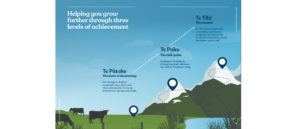If you are a Fonterra supplier, you should have been notified over the past couple of months about changes around the Fonterra Co-operative Difference, both in how it is structured and how payment is made. This is a framework that Fonterra are using to ensure that on-farm practices support the achievement of their strategy. It has changed a little from what was released last year, with the new changes becoming effective as of 1 June 2021.
What you need to know
There are three main levels of achievement to the Fonterra Co-operative Difference:

The three levels of achievement in more detail:
Te Pūtake – the strong sustainable base
Te Puku – the mid-point
Te Tihi – the summit
So where does your veterinarian come in?
Your veterinarian is a key part of your professional advisory team and is not just there to be the ambulance at the bottom of the cliff. For a farmer to achieve the sustainable base, or Te Pūtake, they will now be required to formulate an animal wellbeing plan with their veterinarian. This plan needs to address each of the following topics at a minimum:
For clients who already adopted the discussion with their vet last year, you will notice that there are a couple of additional sections that have recently been added to the Veterinarians’ Animal Wellbeing plan. These sections include: ‘Environment’ – planning for adverse weather events (bothhot and cold and other adverse events eg flood, drought, or earthquake etc), and ‘Behaviour’ – discussion around current and future herd improvement strategies.
Your veterinarian can also assist in achievement of Te Puku. This level is about providing ‘Excellence in milk quality’. We have a lot of information and ideas that can assist you in achieving your targets around milk quality all year round.
Many of these conversations will be planned for the June/July period, but if you want to book sooner with your Vetlife veterinarian, please get in touch with them as soon as possible. Please remember that plans are not limited to the points discussed above, so feel free to discuss any other topics that you see fit to raise.
Susan Geddes, Vetlife Oxford